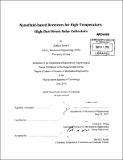Nanofluid-based receivers for high-temperature, high-flux direct solar collectors
Author(s)
Lenert, Andrej
DownloadFull printable version (17.40Mb)
Other Contributors
Massachusetts Institute of Technology. Dept. of Mechanical Engineering.
Advisor
Evelyn N. Wang.
Terms of use
Metadata
Show full item recordAbstract
Solar power plants with surface receivers have low overall energy conversion efficiencies due to large emissive losses at high temperatures. Alternatively, volumetric receivers promise increased performance because solar radiation can be transferred into a fluid medium, which subsequently reduces the concentrated heat at the surface. Nanofluid-based direct solar receivers, where nanoparticles in a liquid medium can scatter and absorb solar radiation, have recently received interest to efficiently distribute and store the thermal energy. In this thesis, a combined modeling and experimental study to investigate the efficiency of fluid-based solar receivers seeded with carbon-coated absorbing nanoparticles is presented. The ability to tune the absorption in a volumetric receiver using the volume fraction of nanoparticles was demonstrated using a semi-empirical method to model the radiative properties of the nanofluid. A volumetric receiver was designed and built to experimentally demonstrate the concept of nanofluid-based receivers and validate the modeling efforts. A one-dimensional combined radiative and heat transfer model was developed to compare idealized surface receivers to idealized volumetric receivers. The effect of particle characteristics such as distribution and selectivity, as well as collector parameters such as absorbing height and level of solar concentration was investigated. In the limit of idealized behavior, non-selective volumetric receivers were shown to be more efficient than selective-surfaces for high concentration levels (C> 100) and/or tall receiver designs (H > 10 cm). The numerical results indicate a major benefit of using volumetric receivers: they are more efficient at higher levels of concentration and can lead to ideal power generation efficiencies exceeding 55% in these regimes. The work offers design guidelines for the development of efficient volumetric receivers for future solar thermal energy conversion systems.
Description
Thesis (S.M.)--Massachusetts Institute of Technology, Dept. of Mechanical Engineering, 2010. Cataloged from PDF version of thesis. Includes bibliographical references (p. 87-88).
Date issued
2010Department
Massachusetts Institute of Technology. Department of Mechanical EngineeringPublisher
Massachusetts Institute of Technology
Keywords
Mechanical Engineering.